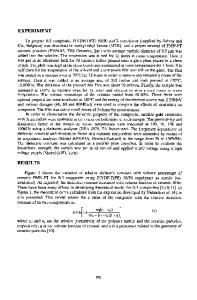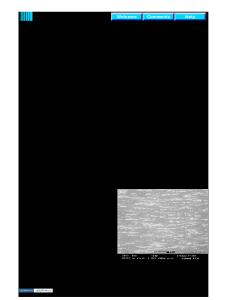Effects of Polymer Material Variations On High Frequency Dielectric Properties
- PDF / 129,224 Bytes
- 7 Pages / 612 x 792 pts (letter) Page_size
- 110 Downloads / 395 Views
1156-D02-05
Effects of Polymer Material Variations on High Frequency Dielectric Properties Gregory T. Pawlikowski Tyco Electronics Corporation, P.O. Box 3608, Harrisburg, PA 17105 ABSTRACT In high frequency signal packaging, the plastic dielectric material takes on an increasingly important role in the performance of the signal transmission. Variations within the plastic can occur as a result of a number of manufacturing and environmental processes. These variations can be sufficient to change the dielectric properties. The extent of change to the dielectric properties of polymer materials as a result of controlled variations to major filler additives, moisture and temperature has been investigated. The combined effects of moisture and temperature can cause changes to the dielectric constant of certain materials by more than 30 %. INTRODUCTION Traditionally, the electrical performance assessment of plastic materials used in electronic packaging focused simply on their insulative nature (high dielectric strength) and their ability to physically isolate adjacent metal conductors. As the frequency of the electrical signals in circuits increases and the spacing between conductors decreases, the electromagnetic properties in the plastic materials play an increasing role in the propagation of the electrical signal. Two important electromagnetic properties in plastic materials are the relative permittivity (or dielectric constant) and dissipation factor (or dielectric loss tangent). The appropriate dielectric constant of a polymer along with the correct geometric design of the system helps reduce the signal-propagation delay and distortion through the electronic package, and minimize cross-talk. Materials with a low dielectric loss tangent can reduce attenuation in circuits, and can improve signal integrity. When designing high speed, high frequency connectors, it is critical to couple the dielectric properties of the plastic housing material with the geometric design in order to obtain the appropriate electrical performance over the desired frequency range. The potential flaw in this design approach is the assumption that the dielectric properties of a specific plastic resin grade will remain constant. A specific grade of plastic resin can undergo a number of changes that can cause shifts in the dielectric constant (Dk) and loss tangent (tan δ) of the material. These dielectric properties of plastic materials are directly influenced by the chemical make-up of the resin formulation (that can include the base polymer, reinforcing fillers, flame retardants), and to a lesser extent processing modifiers, colorants, plasticizers, lubricants, etc. Lot-to-lot variations in the concentrations of the major resin additives (glass fillers and flame retardants) can cause changes in the dielectric properties of a particular resin grade. The dielectric properties of plastic resins are also influenced by the orientation, density and mobility of the dipole moments of polymer repeat units. Even resins from within a specific lot of materia
Data Loading...











